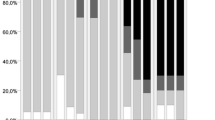Abstract
The aim of this work is to compare the thinning patterns of the ganglion cell inner-plexiform layer (GCIPL) and peripapillary retinal nerve fiber layer (pRNFL) as measured using Cirrus high-definition optical coherence tomography (HD-OCT) in patients with visual field (VF) defects that respect the vertical meridian. Twenty eyes of 11 patients with VF defects that respect the vertical meridian were enrolled retrospectively. The thicknesses of the macular GCIPL and pRNFL were measured using Cirrus HD-OCT. The 5 and 1 % thinning area index (TAI) was calculated as the proportion of abnormally thin sectors at the 5 and 1 % probability level within the area corresponding to the affected VF. The 5 and 1 % TAI were compared between the GCIPL and pRNFL measurements. The color-coded GCIPL deviation map showed a characteristic vertical thinning pattern of the GCIPL, which is also seen in the VF of patients with brain lesions. The 5 and 1 % TAI were significantly higher in the GCIPL measurements than in the pRNFL measurements (all p < 0.01). Macular GCIPL analysis clearly visualized a characteristic topographic pattern of retinal ganglion cell (RGC) loss in patients with VF defects that respect the vertical meridian, unlike pRNFL measurements. Macular GCIPL measurements provide more valuable information than pRNFL measurements for detecting the loss of RGCs in patients with retrograde degeneration of the optic nerve fibers.



Similar content being viewed by others
References
Jindahra P, Petrie A, Plant GT (2012) The time course of retrograde trans-synaptic degeneration following occipital lobe damage in humans. Brain 135:534–541
Jindahra P, Petrie A, Plant GT (2009) Retrograde trans-synaptic retinal ganglion cell loss identified by optical coherence tomography. Brain 132:628–634
Bridge H, Jindahra P, Barbur J, Plant GT (2011) Imaging reveals optic tract degeneration in hemianopia. Invest Ophthalmol Vis Sci 52:382–388
Cowey A, Alexander I, Stoerig P (2011) Transneuronal retrograde degeneration of retinal ganglion cells and optic tract in hemianopic monkeys and humans. Brain 134:2149–2157
Park HY, Park YG, Cho AH, Park CK (2013) Transneuronal retrograde degeneration of the retinal ganglion cells in patients with cerebral infarction. Ophthalmology 120:1292–1299
Tatsumi Y, Kanamori A, Kusuhara A, Nakanishi Y, Kusuhara S, Nakamura M (2005) Retinal nerve fiber layer thickness in optic tract syndrome. Jpn J Ophthalmol 49:294–296
Kanamori A, Nakamura M, Yamada Y, Negi A (2013) Spectral-domain optical coherence tomography detects optic atrophy due to optic tract syndrome. Graefes Arch Clin Exp Ophthalmol 251:591–595
Yamashita T, Miki A, Iguchi Y, Kimura K, Maeda F, Kiryu J (2012) Reduced retinal ganglion cell complex thickness in patients with posterior cerebral artery infarction detected using spectral-domain optical coherence tomography. Jpn J Ophthalmol 56:502–510
Zhang X, Kedar S, Lynn MJ, Newman NJ, Biousse V (2006) Homonymous hemianopias: clinical-anatomic correlations in 904 cases. Neurology 66:906–910
Newman SA, Miller NR (1983) Optic tract syndrome. Neuro-ophthalmologic considerations. Arch Ophthalmol 101:1241–1250
Gilhotra JS (2002) Homonymous visual field defects and stroke in an older population. Stroke 33:2417–2420
Mwanza JC, Oakley JD, Budenz DL, Chang RT, Knight OJ, Feuer WJ (2011) Macular ganglion cell–inner plexiform layer: automated detection and thickness reproducibility with spectral domain-optical coherence tomography in glaucoma. Invest Ophthalmol Vis Sci 52:8323–8329
Mwanza JC, Durbin MK, Budenz DL, Girkin CA, Leung CK, Liebmann JM, Peace JH, Werner JS, Wollstein G (2011) Profile and predictors of normal ganglion cell–inner plexiform layer thickness measured with frequency-domain optical coherence tomography. Invest Ophthalmol Vis Sci 52:7872–7879
Curcio CA, Allen KA (1990) Topography of ganglion cells in human retina. J Comp Neurol 300:5–25
Financial Support
None
Conflict of interest
The authors have no conflict of interest.
Author information
Authors and Affiliations
Corresponding author
Additional information
No author has received any financial support or has a financial interest in any materials or method mentioned in this work.
Rights and permissions
About this article
Cite this article
Shin, HY., Park, HY.L., Choi, JA. et al. Macular ganglion cell–inner plexiform layer thinning in patients with visual field defect that respects the vertical meridian. Graefes Arch Clin Exp Ophthalmol 252, 1501–1507 (2014). https://doi.org/10.1007/s00417-014-2706-3
Received:
Revised:
Accepted:
Published:
Issue Date:
DOI: https://doi.org/10.1007/s00417-014-2706-3




